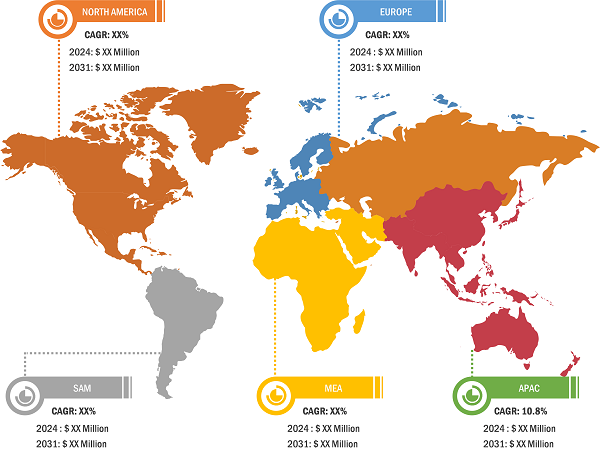Increasing Demand for High Data Rates Boosts RF Front End Module Market Growth
According to our latest study titled “RF Front End Module Market Forecast to 2031 – Global and Regional Share, Trend, and Growth Opportunity Analysis – by Component, End User, and Connectivity,” the market was valued at US$ 3.89 billion in 2024 and is projected to reach US$ 7.58 billion by 2031; it is estimated to register a CAGR of 10.3% during 2025–2031. The report includes growth prospects in light of current RF front end module market trends and factors influencing the market size.
The global demand for high-speed connectivity is experiencing significant growth. As global communication networks shift to faster, more efficient technologies such as 5G, Wi-Fi 6, and beyond, the demand for improved RF components grows. According to the Cambridge University Press, 5G is projected to offer high data rates (1 Gbps) and low latency (<1 ms). 5G requires increased RF bandwidth, which necessitates an increase in the amount of components integrated into a few RF front-end modules, such as RF switches, acoustic filters, and power amplifiers. The 5G network is rapidly growing across the globe. For example, in June 2024, AT&T reported 5G coverage for over 300 million US consumers in 24,900 cities and towns; T-Mobile covered 330 million people across two million square miles, while Verizon is expected to reach 250 million customers. By mid-2023, EchoStar had reached 70% of the US population with 5G. Moreover, the Ministry of Industry and Information Technology (MIIT) reports the deployment of 4.19 million 5G base stations in 2024, with intentions to boost the number to 4.5 million by the end of 2025. The deployment of 5G and 6G networks necessitates high-frequency bands (such as sub-6 GHz and millimeter-wave frequencies), which put a strain on the RF front-end components. This mandates the use of modern RF FEMs capable of efficiently amplifying and processing these signals while reducing power loss and distortion. In 5G networks with several Multiple-Input Multiple-Output (MIMO) antennas, the RF Front End module is important for sending and receiving signals efficiently. It also helps manage and coordinate many antennas while keeping data rates high and latency low. Further, 6G is expected to operate at terahertz (THz) frequencies, greatly above the present 5G millimeter-wave bands. To achieve these requirements, RF FEMs must be built for high-frequency operation and use sophisticated materials (such as graphene or another semiconductor). Thus, the increasing demand for high data rates propels the RF Front End module market growth.
RF Front End Module Market – by Region, 2024 and 2031
RF Front End Module Market Size and Forecast (2021 - 2031), Global and Regional Share, Trend, and Growth Opportunity Analysis Report Coverage: By Component (RF Filter, RF Power Amplifier, RF Switch, and Others), End User (Consumer Electronics, Telecommunication, Automotive, Defense and Military, and Others), Connectivity (Wi-Fi, Bluetooth, and Others), and Geography
RF Front End Module Market Key Findings, Size, Share by 2031
Download Free Sample
Source: The Insight Partners Analysis
The RF Front End Module market analysis has been carried out by considering the following segments: component, end user, and connectivity. Based on the component, the market is segmented into RF power amplifiers, RF filters, RF switches, and others. Based on end user, the market is segmented into consumer electronics, automotive, defense and military, telecommunication, and others. Based on the connectivity, the market is segmented Wi-Fi, Bluetooth, and others. The Wi-Fi segment held the largest RF Front End Module market share in 2024.
The scope of the RF Front End Module market report is primarily segmented into North America (US, Canada, and Mexico), Europe (Russia, UK, Germany, France, Italy, and Rest of Europe), Asia Pacific (South Korea, China, India, Japan, Australia, and Rest of Asia Pacific), Middle East & Africa (UAE, Saudi Arabia, South Africa, and Rest of MEA), and South & Central America (Brazil, Argentina, and Rest of SAM). Asia Pacific accounted for the largest RF Front End Module market share in 2024. The growing demand for smartphones among consumers in Asia Pacific countries drives the RF front end module market. According to the GSM Association of July 2023, smartphone adoption in Asia Pacific is expected to increase to 94% by 2030, with a 76% increase from 2022, owing to improved digital literacy, high internet connectivity, and availability of affordable devices. The rise in smartphone adoption surges the demand for RF front end modules among smartphone manufacturers to develop thinner, compact, and advanced advanced-featured smartphones. As consumers in Asia Pacific increasingly demand more advanced featured smartphones with high camera quality, improved signal strength, and 5G connection, it increases the demand for sophisticated RF front-end modules. These modules are capable of performing complicated operations such as signal amplification, filtering, and power management.
Analog Devices Inc., Broadcom Inc., Murata Manufacturing Co Ltd., Qorvo Inc., Skyworks Solutions Inc., Microchip Technology Inc., NXP Semiconductors NV, Qualcomm Inc., Infineon Technologies AG, and TDK Corp are among the key players profiled in the RF Front End Module market report.
Contact Us
Phone: +1-646-491-9876
Email Id: sales@theinsightpartners.com